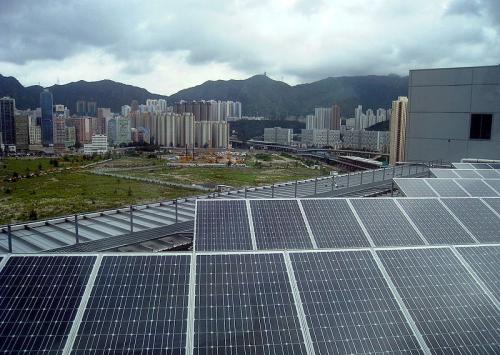Solar energy in the trade war
The Chinese government has launched a plan to generate renewable energy on a massive scale.
- Análisis

The change in the energy matrix plays a fundamental role in the development of the trade war, as we have mentioned before (http://obela.org/analisis/el-papel-del-litio-en-la-guerra-comercial). Photovoltaic cells and solar panels have been subject to various US sanctions as a tool against Chinese expansion in this sector and in general for the search for alternative energies.
China recognizes in its 12th five-year plan, the great environmental deterioration due to its rapid industrial expansion, and that its energy sources have been highly polluting. For the time being, they will continue to generate energy through coal, but the growing commitment is to the generation of renewable energies on a larger scale. The Chinese government has launched a plan to generate renewable energy on a massive scale, starting with the same plan in 2011. It considers innovation and the search for alternative energy sources to be "Strategic Emerging Industries, [...] vital for the evolution of Chinese industry, and which it intends to develop rapidly".1
The US has attacked solar panels based on its national security strategy and particularly with accusations of unfair international trade practices (dumping) towards Chinese cells and panels. In this way it has disassociated itself from almost any form of alternative energy.
The Trump administration's national security strategy aims to make the U.S. "[...] an energy-dominant nation for the first time in generations. ... the United States will work with allies and partners to protect the global energy infrastructure from physical and other threats2. He emphasizes that "Climate policies will continue to shape the global energy system. U.S. leadership is indispensable to counter an anti-growth energy agenda that harms U.S. economic and energy security interests3.
The Trump administration's commitment to fossil fuels and against clean energy is clear, particularly against China. An example of this is the accusation of dumping since November 2012, when the U.S. Department of Commerce, based on an investigation by the U.S. International Trade Commission (USITC), accused China of selling photovoltaic cells in its market at a price less than fair, based on subsidies from the Chinese government.
The commission interpreted this low price as dumping, and blamed it for the destruction of the US solar panel industry4. The unilateral conclusion in January 2018 was to impose a 30% countervailing tariff in the first year5 on solar panel and cell industries in China and Taiwan, in addition to the existing 30% tariff on any country, which in 2019 was reduced to 25%, or 55% in net terms6.
The accusation goes hand in hand with the expansion of the solar panel trade in recent years. However, China's exports of these products to the US increased by approximately 500%, while the price fell by 60%. Meanwhile, Germany's production costs fell and it became the second largest producer and exporter of solar panels in Europe in the same years.
The demand for dumping of Chinese solar panels was shared by the European Union, however, it was withdrawn when the trade relationship with China was considered "too big to fail".7 In this way, a trade war was avoided. Germany, as one of the leading producers of solar energy equipment, imports photovoltaic devices from Asia by 80%.8 The production of solar energy from solar panels is very significant and depends on continued imports from Asia.
The trade in solar panels and cells did not fall sharply in China with the trade war. Renewable projects from photovoltaic energy are increasingly significant in the world, with solar parks in several countries taking advantage of China and some other Asian countries as suppliers. In Latin America, there are large projects such as Cauchari, in Jujuy, Argentina, in Chihuahua, Mexico, as well as in Chile and other countries. Even in the USA, mainly in California, Florida and other states, the low cost of panels and batteries has been used to build projects of this type, with tariffs and all9.
- Oscar Ugarteche, Investigador titular, Instituto de Investigaciones Económicas UNAM, coordinador proyecto www.obela.org
- Arturo Martínez Paredes, Facultad de economía UNAM, miembro del proyecto www.obela.org
Source: OBELA, Observatorio Económico Latinoamericano, UNAM
Num.03, Year 2020
24th February
1 http://www.proglocode.unam.mx/sites/proglocode.unam.mx/files/%C3%BAltimo%20plan%20quinquenal%20China.pdf
3 Ibid.
4 Unfortunately the USITC report presented censored figures about the US solar industry itself, so it is difficult to understand their verdict.
6 https://www.solarpowerworldonline.com/2018/08/its-official-chinese-solar-cells-and-modules-hit-with-additional-25-tariff/
Del mismo autor
- El multilateralismo bipolar 08/03/2022
- Bipolar multilateralism 07/03/2022
- What does 2022 bring? Uncertainty 31/01/2022
- ¿Qué trae el 2022? Incertidumbre 31/01/2022
- The most expensive Christmas of the century... (so far) 20/01/2022
- La navidad más cara del siglo (hasta ahora) 20/01/2022
- Lo que pasó en el 2021 10/01/2022
- What happened in 2021 10/01/2022
- Estados Unidos: el elefante en la habitación 08/11/2021
- The elephant in the room 07/11/2021
Clasificado en
Clasificado en:
China-EEUU
- Umberto Mazzei 10/06/2021
- Umberto Mazzei 09/06/2021
- Michael Klare 08/04/2021
- Matthew Ehret 24/03/2021
- Lejeune Mirhan 16/02/2021
